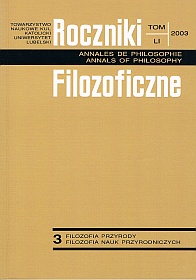The Problem of Prions' Location in the Area of Borderland of Life
Abstract
The status of prions' attachment to the biotic or abiotic sphere is not established. In consideration of structure prions are infections proteins – in case of animals and human being – constructs from the specifically protein calls PrPc, which PrPSc form is a prion. The prions were indicating also at fungi ([PSI] and [URE]) and yeast ([het-s]). There are big probability occurrences of prions at some another organisms, too.
According to cybernetic approach to the life organism, prions positively fulfil conditions: semi-opennesness (half-openness), complexity, hierarchicalness and structure. There are formulates some of doubts about possibility of fulfils by prion conditions of program and cybernetic system. In addition the phenomenon of self-multiplication of prion has not unequivocally estimation.
In the formulation of Tibor Gánti's life system, prion positively realises some requirements: coherent whole, coherent stability, control, and mortality. In my opinion prions negative fulfils condition: metabolism and phenomenon of adjustment. We also not observe at prions: system, which takes information, phenomenon of growth, reproduction, and heredity of changes and evolution. Final inference: it is a lack today some of precise conclusions about biotic or abiotic nature of prions.
References
Ashraf H.: Early Results of Study into vCJD Epidemic Inconclusive. „The Lancet” 355:2000 s. 1619.
Boguta M.: Priony u drożdży i grzybów nitkowatych. „Postępy Biochemii” 46:2000 nr2 s. 108-114.
Carp R. I., Ye X., Kascsak R. J., Rubenstein R.: The Nature of the Scrapie Agent: Biological Characteristics of Scrapie in Different Scrapie Stain-host Combinations. „Annals of the New York Academy of Science” 1994 No. 724 s. 221-234.
Cohen F. E., Prusiner S. B.: Pathologic Conformations of Prion Proteins. „Annual Reviews of Biochemistry” 1998 No. 67 s. 793-819.
Dickinson A. G., Outram G. W.: Genetic Aspects of Unconventional Virus Infections: The Basis of the Virino Hypothesis. „Ciba Foundation Symposium” 1988 No. 135 s.63-83.
Dyk W.: Termodynamiczne aspekty genezy życia. W: Z zagadnień filozofii przyrodoznawstwa i filozofii przyrody. T. 15. Red. M. Lubański, W. Sz. Ślaga. Warszawa: ATK 1996 s.13-179.
Dyson F.: Początki życia. Tł. P. Golik. Warszawa: PWN 1993.
Eigen M., Winkler R.: Gra. Prawa natury sterują przypadkiem. Tł. K. Wolicki. Warszawa: PIW 1983.
Gánti T.: Podstawy życia. Tł. T. Kulisiewicz. Warszawa: „Wiedza Powszechna” 1986.
Haywood A. M.: Transmissible Spongiform Encephalopaties. „The New England Journal of Medicine” 1997 No. 337 s.1821-1828.
Jakubiec M., Boguta M.: Prion [PSI] i jego wpływ na terminacje translacji udrożdży Saccharomyces cerevisiae. „Postępy Biochemii” 48:2002 nr 3 s.175-181.
Kłósak K.: Hipoteza samorództwa wobec badań nad wirusami. „Znak” 1952 z. 1 s. 1-16.
Kłósak K.: W poszukiwaniu Pierwszej Przyczyny. T. 1. Warszawa 1955.
Liberski P. P.: Nagroda Nobla za priony. „Postępy Biochemii” 43:1997 nr 4 s. 229n.
Liberski P. P., Bratosiewicz J.: Pasażowalne amyloidozy mózgowe, czyli choroby wywołane przez priony: czy struktura scrapie jest już rzeczywiście znana? Tamże 42:1996 nr 4 s.320-330.
Liebman S. W., Derkatch I. L.: The Yeast [PSI+] Prion: Making Sense of Nonsense. „The Journal of Biological Chemistry” 274:1999 No.3 s. 1181-1184.
Macek K. (oprac.): Priony. „Gazeta Lekarska” 1997 nr 12 (http://www.nil.prg.pl./gazeta/ g197/12-97-28.htm) s. 1-4.
Pammer J., Suchy A., Rendl M., Tschachler E.: Cellular Prion Protein Expressed by Bovine Squamous Epithelia of Skin and Upper Gastrointestinal Tract. „The Lancet” 354:1999 s. 1702n.
PRP May Have Role in Copper Metabolism. „Bloodweekly” World News April 19 1999 s.2.
PrusinerS. B.: Choroby prionowe. „Świat Nauki” 1995 nr 3 (43) s.46-54.
PrusinerS. B.: Novel Proteinaceous Infections Particles Cause Scrape. „Science” 1982 No.216 s. 136-144.
PrusinerS. B.: Prions. „Proceedings of the National Academy of Science of the USA” 1998 No. 95 s.13363-13383.
PrusinerS. B., Scott M., DeArmond S. J., Cohen F. E.: Prion Protein Biology. „Cell” 1998 No. 93 s. 337-348.
Soto C., Kascsak R. J., Saborio G. P. [et al.]: Reversion of Prion Protein Conformational Changes by Synthetic b-sheet Breaker Peptides. „The Lancet” 355:2000 s.192-197.
Szymański J. M.: Życie systemów. Warszawa: „Wiedza Powszechna” 1991.
Ślaga Sz. W.: Japońskie doświadczenia nad wirusami a problem pochodzenia życia. „Zeszyty Naukowe KUL” 8:1965 nr 1 (29) s. 37-49.
Ślaga Sz. W.: Powstanie życia wobec genezy i ewolucji wirusów. „Studia Philosophiae Christianae” 3:1967 nr 1 s. 193-228.
Ślaga Sz. W.: Problem konfirmacji teorii abiogenezy w świetle badań Wowka nad wirusami. W: Z zagadnień filozofii przyrodoznawstwa i filozofii przyrody. T.1. Red. K. Kłósak. Warszawa: ATK 1976 s. 107-139.
Wickner R. B., Edskes H. K., Maddelein M.-L., Taylor K. L., Moriyama H.: Prions of Yeast and Fungi. „The Journal of Biological Chemistry” 274:1999 No. 2 s. 555-558.
Zhang Y., Swietnicki W., Zagórski M. G., Surewicz W. K., Sönnichsen F. D.: Solition Structure of the E200K Variant of Human Prion Protein. Implications for the Mechanism of Pathogenesis in Familial Prion Diseases. Tamże 275:2000 s. 33650-33654.
Zięba S.: Filozoficzne zagadnienie odrębności bytu ożywionego. „Roczniki Filozoficzne” 26:1978 z. 3 s. 131-151.
Zięba S.: Próba charakterystyki bytu ożywionego. W: Zarys filozofii przyrody ożywionej. Red. S. Mazierski. Lublin: RW KUL 1980 s. 279-296.
Copyright (c) 2003 Roczniki Filozoficzne

This work is licensed under a Creative Commons Attribution-NonCommercial-NoDerivatives 4.0 International License.





